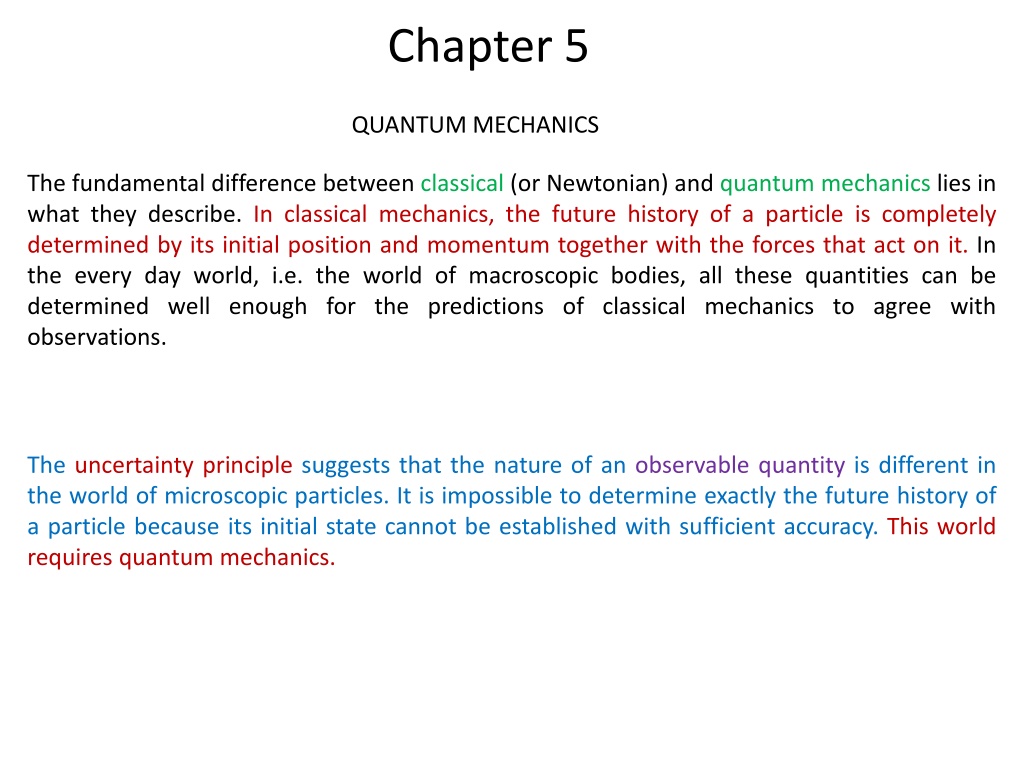
Exploring the Fundamental Differences in Quantum Mechanics
Understanding the shift from classical to quantum mechanics, this chapter delves into the uncertainty principle, probabilities, and the concept of wave functions. It highlights how quantum mechanics challenges our traditional views by emphasizing probabilistic outcomes and the role of wave functions in determining the behavior of particles.
Download Presentation

Please find below an Image/Link to download the presentation.
The content on the website is provided AS IS for your information and personal use only. It may not be sold, licensed, or shared on other websites without obtaining consent from the author. If you encounter any issues during the download, it is possible that the publisher has removed the file from their server.
You are allowed to download the files provided on this website for personal or commercial use, subject to the condition that they are used lawfully. All files are the property of their respective owners.
The content on the website is provided AS IS for your information and personal use only. It may not be sold, licensed, or shared on other websites without obtaining consent from the author.
E N D
Presentation Transcript
Chapter 5 QUANTUM MECHANICS The fundamental difference between classical (or Newtonian) and quantum mechanics lies in what they describe. In classical mechanics, the future history of a particle is completely determined by its initial position and momentum together with the forces that act on it. In the every day world, i.e. the world of macroscopic bodies, all these quantities can be determined well enough for the predictions of classical mechanics to agree with observations. The uncertainty principle suggests that the nature of an observable quantity is different in the world of microscopic particles. It is impossible to determine exactly the future history of a particle because its initial state cannot be established with sufficient accuracy. This world requires quantum mechanics.
The quantities whose relationships quantum mechanics explores are probabilities. For example, instead of asserting that the radius of the electron's orbit in the ground-state hydrogen atom is 5.3 10-11 m, as the Bohr Theory does, quantum mechanics states that this is the most probable radius. In a suitable experiment most trials will yield different values, either larger or smaller, the value most likely to be found will be 5.3 10-11m. Classical mechanics is an approximate version of quantum mechanics. The certainties in classical mechanics are illusory, and their apparent agreement with experiment occurs because ordinary objects consist of so many individual atoms that departures from average behavior are unnoticeable.
Wave function The quantity with which quantum mechanics is concerned is the wave function of a body. The wave function itself has no physical interpretation. However, the square of its absolute value, | (x,t)|2 , evaluated at a particular place x at a given time t, is proportional to the probability of finding the body there at that time. The probabilities of all other characteristics of the body, such as linear momentum, angular momentum, and energy, can also be established from . The problem of quantum mechanics is to determine for a body when its freedom of motion is limited by the action of external forces. Wave functions are usually complex, with both real and imaginary parts. Every complex wave function can be written as ???? ???????? ? = ? + ?? ? ??? ? ??? ? ??? ???? ?????????. The complex conjugate is ? = ? ??
The probability density is |?|2= ?? = ?2+ ?2 Thus the probability density P | |2 is always a positive real number, as required. We now establish certain requirements for . Since | |2 is proportional to the probability of finding the body at a point, the integral of | |2 over all space, |?|2?? Is proportional to the probability of finding the body somewhere in space. Therefore, this integral must be finite. It cannot be 0 or 1. If this integral is zero, the particle does not exist. If this integral is 1, it cannot have the meaning of a probability.
It is convenient to have||2 be equal to the probability density P of finding the particle. If so, then it must be true that |?|2?? = 1 (5 1) Because ??? = 1 A wave function that satisfies Eq.(5-1) is said to be normalized. Every acceptable wave function can be normalized by multiplying it by an appropriate constant.
Besides being normalizable, must be single- valued since P can have only one value at a particular place and time. must also be continuous. On the other hand, the momentum ?? ??,?? ??,?? components are proportional to the partial derivatives ?? Therefore, these derivatives must be finite, continuous, and single-valued. Only wave functions with all these properties can yield physically meaningful results when used in calculations, so only such well-behaved wave functions are admissible as mathematical representations of real bodies. To summarize: 1. must be single-valued and continuous everywhere. 2.?? ??,?? ??,?? ?? must be single-valued and continuous everywhere. 3. must be normalizable, which means that must go to 0 as x, y, or z tends to in order that |?|2?? Over all space be a finite constant.
Given a normalized and otherwise acceptable wave function , the probability that the particle it describes will be found in a certain region is simply the integral of the probability density | |2 over that region. Thus for a particle restricted to motion in the x direction, the probability of finding it between x1 and x2 is given by ?2 |?|2?? ??????????? ??1?2= (5 2) ?1
SCHRODINGER EQUATION Schr dinger s equation, which is the fundamental equation of quantum mechanics in the same sense that the second law of motion is the fundamental equation of Newtonian mechanics, is a wave equation in the variable . Wave equation Consider a wave whose variable quantity is y. Assume that this wave propagates in the x direction with the speed . Then, the propagation of the wave is described by the wave equation ?2? ??2= ?2? ??2 1 ?2 (5 3) All the solutions of the above equation must be of the form ? = ? ? ? ? (5 4)
where F is any function that can be differentiated. The solutions F(t- x/v) represent waves traveling in the +x direction, and the solutions F(t + x/v) represent waves traveling in the -x direction. Consider the wave equivalent of a free particle moving in the +x direction. This wave is described as an undammed, monochromatic harmonic wave ? = ?? ??(? ? ?) (5 5)
Time-dependent Schrodinger equation In quantum mechanics, a particle is described by a wave function . We assume that the wave function of a free particle moving along the +x direction is specified by ? = ?? ??(? ? ?) (5 6) When we use the relations W =2??and = ?, we have ? = ?? 2??(?? ? ?) (5 7) In terms of the total energy E = h? =2? ?and the momentum p = h/ =2? / , the wave function of the free particle is ? = ?? (? )(?? ??) (5 8)
We differentiate Eq.(5-8) twice with respect to x. Then we obtain ?2? ??2= ?2 2 ? ?2? = 2?2? ??2 (5 9) Differentiating Eq. (5.8) once with respect to t gives ?? ??= ?? ? ?? = ?? ?? (5 10) ?
Assume that Eqs. (5-9) and (5-10) are valid for an arbitrary particle. Assume that the velocity of the particle is small compared to the light velocity c. Then, the total energy E of the particle is the sum of its kinetic energy p2 /2m and its potential energy U(x;t): ? =?2 2?+ ? ?,? (5 11) Multiplying both sides of Eq. (5.11) by the wave function gives ?? =?2? 2?+ ?? (5 12) Now we substitute for E and p2 from Eqs. (5.9) and (5.10) to obtain the time- dependent form of Schr dinger s equation: ??= 2 ?2? ??2+ ?? ? ?? (5 13) 2? This is the time-dependent Schr dinger equation in one dimension.
In three dimensions, the time-dependent Schrdinger equation is ??= 2 2?(?2? ??2+?2? ??2+?2? ? ?? ??2) + ?? (5 14) Here, the potential energy U is a function of x, y, z, and t. The Schr dinger equation is a basic principle. It must be postulated. It cannot be derived from other principles of physics.
EXPECTATION VALUES How to extract information from a wave function The wave function of a particle contains all the information about the particle. How to extract information from the wave function? As an example, let us calculate the expectation value x of the position of a particle that is described by the wave function (x,t) in one dimension. To make the procedure clear, we first consider a number of identical particles. Assume that there are N1 particles at x1, N2 particles at x2, and soon. The average position is then given by = ???? ?? ? =?1?1+ ?2?2+ ?3?3+ ?1+ ?2+ ?3+ (5 15)
When we are dealing with a single particle, we must replace the number Ni of particles at xi by the probability Pi that the particle be found in an interval dx at xi. This probability is ??= |?|2?? (5 16) Where i is the wave function evaluated at x = xi. Making the substitution Ni = Pi = | |2dx and changing the summations to integrals, we find that the expectation value of the position of the single particle is ? |?|2?? |?|2?? < ? > = (5 17) |?|2?? = 1 .When is We say that is a normalized wave function if normalized, the expectation value for position is
? |?|2?? < ? > = (5 18) In more general, consider an arbitrary quantity G(x) that depends on the position x but not on the momentum p. The expectation value of this quantity is calculated as ? ? ?2?? < ?(?) > = (5 19) The expectation value <p> for momentum cannot be calculated this way because, according to the uncertainty principle, no such function as p(x) can exist. Indeed, if we specify x, so that x =0, we cannot specify a corresponding p since x p /2.The same problem occurs for the expectation value <E> for energy.
Example A particle limited to the x axis has the wave function = ax between x =0 and x =1; =0 elsewhere. (a) Find a for which is normalized wave function. (b) Find the probability that the particle can be found between x = 0.45 and x = 0.55. (c) Find the expectation value <x> of the particle s position. Solution (a)The constant a satisfies the normalization condition 1 1 ?2?? = ?2?3 3=?2 ?2?? = 1 = ?2 3 0 0 Hence we find ? = 3
(b) The probability is ?2 0.55 ?2?? = ?2?3 ?2?? = ?2 3= 0.0251 ?2= 0.0753 ?1 0.45 (c) The expectation value for position is 1 1 ?3?? = ?2?4 4=?2 4=3 ? ?2?? = ?2 < ? > = 4. 0 0
5.6 OPERATORS Another way to find expectation values An operator is a rule or an instruction which transforms a function into another function. A hint as to the proper way to evaluate p and E comes from differentiating the free- particle wave function = ?? (? )( ?? ?? with respect to x and to t. We find that ? ??=? ? ? ??= ? ? which can be written in the suggestive forms
? = ? ?? (5 20) ? ? = ? ? ?? (5 21) It is customary to denote operators by using a caret, so that ? is the operator that corresponds to momentum p and is the operator that corresponds to total energy E. From Eqs. (5.20) and (5.21) these operators are ? = ? ?? ???????? ??????? (5 22) ? = ? ? ????? ?????? ???????? ?? (5 23)
Though we have only shown that the correspondences expressed in Eqs. (5.22) and (5.23) hold for free particles; they are entirely general results whose validity is the same as that of Schr dinger s equation. To support this statement, we can re-place the equation E = KE + U for the total energy of a particle with the operator equation = ?? + ? (5 24) The operator U is just U( ). The kinetic energy KE is given in terms of momentum p by ?? =?2 2? And so we have ?2 2?= ? ??)2= 2 ?2 ??2 (5 25) 2?( 1 ?? = ??????? ?????? ???????? ? 2?
Equation (5-24) therefore reads ??= 2 ?2 ??2+ ? ? ? (5 26) 2? Now we multiply the identity = by Eq. (5.26) and obtain ??= 2 ?2 ??2+ ? ? ? 2? which is Schr dinger s equation. Postulating Eqs. (5.22) and (5.23) is equivalent to postulating Schr dinger s equation.
Operators and Expectation Values Because p and E can be replaced by their corresponding operators in an equation, we can use these operators to obtain expectation values for p and E. Thus the expectation value for p is ? ? ? ? ?? = < ? > = ?? = ? ???? (5 27) ?? And the expectation value for E is ? ? ? ? ?? = < ? > = ?? = ? ???? (5 28) ?? Both Eqs. (5.27) and (5.28) can be evaluated for any acceptable wave function (x, t).
Let us see why expectation values involving operators have to be expressed in the form ? ?? < ? > = The other alternative are ? ? ?? = ??( )?? = = 0 ? ? Since ??? must be 0 at x= , and ? ?? = ? ? ????
which makes no sense. In the case of algebraic quantities such as x and V(x), the order of factors in the integrand is unimportant, but when differential operators are involved, the correct order of factors must be observed. Every observable quantity G characteristic of a physical system may be represented by a suitable quantum-mechanical operator G . To obtain this operator, we express G in terms ? the expectation value of G(x, p) is ? ??.If the wave function of the system is known, of x and p and then replace p by ? ?? (5.29) ?????????? ????? ?? ?? ???????? < ? ?,? >= In this way all the information about a system that is permitted by the uncertainty principle can be obtained from its wave function .
Steady-state Schrodinger equation Note that the wave function of a free particle (U = 0) can be written as ? = ?? (? )(?? ??) = ? ? ? ????/ = ? ? ? ?? ?? (5 30) where ? depends on position but not on time. Consider the case where the particle is not free. Assume that the potential U is a function of x but is independent of time. Consider the situation where the wave function can be written in the form ? = ? ? ? ?? where ? is independent of time. This situation is called the steady state. Substituting Eq. (5-30) in to Eq. (5-13), we find
?? = 2 ???2? ?? ? ? 2? ? ? ??2+ ?? ? ? ?? Dividing the above equation by the common exponential factor gives ?2? ??2+2? 2? ? ? = 0 (5 31) The above equation is called the steady-state Schrodinger equation in one dimension. In three dimensions, the steady-state Schrodinger equation is ?2? ??2+?2? ??2+?2? ??2+2? 2? ? ? = 0 (5 32) An important property of the steady-state Schrodinger equation is that, if it has one or more solutions for a given system, each of these solutions corresponds to a specific value of the energy E. That is how energy quantization appears in quantum mechanics.
Eigen values and Eigen functions The values of energy En for which the steady-state Schrodinger equation can be solved are called Eigen values or Eigen energies. The corresponding wave functions ?n are called Eigen functions or Eigen states. An example of a set of Eigen energies is the discrete energy levels of the hydrogen atom: ??4 1 ?2 , ??= ??? ? = 1,2,3, 32?2 02 2
Operators and Eigenvalues The condition that a certain dynamical variable G be restricted to the discrete values Gn in other words, that G be quantized is that the wave functions n of the system be such that ? ?= ?? ? ?????????? ???????? (5 33) where G is the operator that corresponds to G and each Gn is a real number. When Eq. (5.33) holds for the wave functions of a system, it is a fundamental postulate of quantum mechanics that any measurement of G can only yield one of the values Gn. If measurements of G are made on a number of identical systems all in states described by the particular Eigen function k, each measurement will yield the single value Gk.
Example An Eigen function of the operator ?2 ??2 ?? = ?2?.???? ? ? ????????????? ??????????. Solution ?2 ??2 ,?? Here ? = ?2 ??2?2?= ? ?? ? ?? ? ?? ? = ?2? 2?2?= 4?2? = But ?2?= ,?? ? = 4 From Eq. (5.34) we see that the eigenvalue G here is just G = 4.
In view of Eqs. (5.24) and (5.25) the total-energy operator Eof Eq. (5.23) can also be written as ? = 2 ?2 ??2+ ? ??????????? ???????? (5.34) 2? and is called the Hamiltonian operator because it is reminiscent of the Hamiltonian function in advanced classical mechanics, which is an expression for the total energy of a system in terms of coordinates and momenta only. Evidently the steady-state Schr dinger equation can be written simply as ? ?= ?? ? ?? ????????? ???????? (5.35)
so we can say that the various En are the eigenvalues of the Hamiltonian operator H. This kind of association between eigenvalues and quantum-mechanical operators is quite general. Table 5.1 lists the operators that correspond to various observable quantities. Table 5.1 Operators Associated with Various Observable Quantities
PARTICLE IN A BOX The simplest quantum- mechanical problem is that of a particle trapped in a box with infinitely hard walls. Consider a particle that is restricted to traveling along the x axis between x = 0and x = L by infinitely hard walls. This situation can be described by the potential energy U that is infinite on both sides of the box and is a finite constant on the inside. Because the particle cannot have an infinite amount of energy, it cannot exist outside the box. Hence, the wave function ? is zero for x 0 and x L. We will calculate the steady-state wave function ? for the inside of the box. FIG.5.1: An infinite potential.
Inside the box, U is a constant. For convenience, we take U = 0 for the inside of the box. Then, the steady- state Schrodinger equation (5-21) becomes ?2? ??2+2? 2?? = 0 (5 36) ?2 ?x2 Since U = 0 there. (The total derivative d2 /dx2 is the same as the partial derivative because is a function only of x in this problem. The general solution of the above equation is 2?? 2?? ? = ?sin ? + ???? ? (5 37) Here, A and B are coefficients to be evaluated.
The boundary conditions are ? (0)=0 and ?(L) = 0. From ? (0) = 0, sin 0 = 0 and cos 0 =1,we 2?? find B = 0. The condition ? (L)= 0 will be satisfied if sin = 0, that is, if 2mE ? = n , with n = 1,2,3 (5 38) Hence, the energy of the particle can have only certain values ??=?2?2 2 ???????? ?? ? ??? 2??2 ? = 1,2,3, .. (5 39) The above values are the Eigen energies of the particle. They constitute the energy levels of the particle.
Wave function of a particle in a box Since B = 0, the wave function of the particle inside a box is 2??? ??= ?sin ? (5 40) Using Eq.(5-39) for En, we find ??= ?sin??? (5 41) ? It is easy to verify that the above wave function satisfies the steady- state Schrodinger equation and the boundary conditions ?(0)= ?(L)= 0. Note that Eq.(5-41) is valid only for 0 x L. Outside the box, we have ?n = 0. We also note that the spatial derivative ?n of the wave function (5-41) is not continuous at x =0 as well as at x = L. The reason is that the box with infinitely hard walls is just an approximate model, not a realistic situation.
To find the constant A, we calculate the integral of |n|2 from x = - to x =+. We find ? ? sin2??? ?2?? = ?2?? = ?2 ?? ? 0 0 ? ?2 2 ?? = ?2? 1 ???2??? = (5 42) ? 2 0 To satisfy the normalization condition |?|2?? = 1 (5 43) We choose 2 ? ? = (5 44)
Thus the normalized wave functions of the particle are 2 ?sin??? ???????? ?? ? ??? ??= ??? ? = 1,2,3, (5 45) ? The normalized wave functions ?1, ? 2 and ? 3 together with the probability densities | 1|2,| 2|2 and | 3|2 are plotted in Fig. 5.2. As seen, ?n = 0 at x = 0 and x = L. At a particular place in the box, the probability of finding the particle may be very different for different quantum numbers. For example,
Fig.5.2: Wave functions and probability densities of a particle in a box with rigid walls. | 1|2 has its maximum value in the middle of the box, while | 2|2 = 0 there. In other words, a particle in the lowest energy level of n =1 is most likely to be in the middle of the box, while a particle in the next higher state of n =2 is never there. Classical physics, of course, suggests the same probability for the particle being anywhere in the box.
Example Find the probability that a particle trapped in a box L wide can be found between 0.45L and 0.55L for the ground and first excited states. Solution This part of the box is one-tenth of the box s width and is centered on the middle of the box. Classically we would expect the particle to be in this region 10 percent of the time. Quantum mechanics gives quite different predictions that depend on the quantum number of the particle s state. The probability of finding the particle between x1 and x2 when it is in the nth state is ?2 ?2 ?2 | ?|2?? =2 ???2??? ?? = (? 2??sin2??? 1 ??1?2= ? ? ) ?1 ? ? ?1 ?1 =?2 ?1 ???????(?2+ ?1) 1 ?????(?2 ?1) ? ? ?
For x1=0.45 L and x2 = 0.55 L, we obtain 10+ ( 1)?+1 ????? 1 ??????? ????? 1 1 10 ??1?2= 10 10= ?? For the ground state, which corresponds to n =1, we have ??1?2= 0.198 = 19.8% This is about twice the classical probability. For the first excited state, which corresponds to n =2, we have ??1?2= 0.0065 = 0.65% This low probability is consistent with the fact that | 2|2 = 0 at x = 0.5 L. Note that, when n is very large, we have Px1x2 (x2-x1) = L. This result is in agreement with classical physics, as required by the correspondence principle.
Example Consider a particle trapped in a box of with L. Find the expectation value <x of the position of the particle. Solution 2??? ? 4?? ? 2??? ? ???? ??? ? ? ?2 4 ? 2?? =2 ????2??? ?? =2 =? < ? = ? 2 8?? ? ? 2 0 0 ? This result means that the average position of the particle is the middle of the box. It reflects the symmetry of the system. There is no conflict with the fact that |?n|2=0 at L/2 for the states of n =2, 4, 6, because <x is an average, not a probability.
Finite potential well Potential energies are never infinite in the real world. Therefore, the box with infinitely hard walls has no physical counterpart. However, potential wells with barriers of finite heights certainly do exist. Consider a potential well with square corners that is U high and L wide and contains a particle whose energy E is less than U. According to classical mechanics, when the particle strikes the sides of the well, it bounces off without entering regions I and III. In quantum mechanics, the particle also bounces back and forth, but now it has a probability of penetrating in to regions I and III even though E<U. Fig. 5.3 A finite potential well.
In regions I and III, the steady-state Schrodinger equation is ?2? ??2+2? 2? ? ? = 0 We rewrite the above equation as ?2? ??2 ?2? = 0 , ? < 0 ??? ? > ? (5 46) 2?(? ?) Where ? = 0. The solution to eq.(5-46) are ??= ????+ ?? ?? (5 47) ????= ????+ ?? ?? (5 48)
Fig.5.4 Wave functions and probability densities of a particle in a finite potential well. Both ?I and ?III must be finite everywhere. Since ? ?? ?? ? ??? ??? ?? ? ,? ? ???????????? ? ??? ? ???? ?? ????. ???? ?? ??? ??= ???? (5 49) ????= ?? ?? (5 50)
These wave functions decrease exponentially inside the barrier at the sides of the well. Inside the well, the steady-state Schrodinger equation is the same as Eq.(5-36), that is, ?2? ??2+2? 2?? = 0 The solution is again 2?? 2?? ???= ? sin ? +? cos ? (5 51) In the case of a well with infinitely high barriers, we found that F = 0 in order that ? =0 at x =0 and x = L. Here, because ?II = A at x = 0 and ?II = D at x = L, both the sine and cosine components in the solution (5-51) are possible.
For either solution, both ? and d? /dx must be continuous at x = 0 and x = L. The wave functions inside and outside each side of the well must have the same values and the same slopes where they join. When these boundary conditions are taken into account, we find that exact matching occurs only for certain specific values En of the particle energy.
HARMONIC OSCILLATOR Its energy levels are evenly spaced In the special case of simple harmonic motion, the restoring force F on a particle of mass m is linear; that is, F is proportional to the particle s displacement x from its equilibrium position and in the opposite direction. Thus ?????? ??? ? = ?? From the second law of motion, F=ma, we have ?? = ??2? ??2 ?2? ??2+? ??????? ????????? ?? = 0 (5 52) a common solution of equation (5-52) is
? = ???? 2??? + (5 53) Where 1 ? ? ????????? ?? ??????? ????????? ? = (5 54) 2? is the frequency of the oscillations and A is their amplitude. The value of , the phase angle, depends upon what x is at the time t = 0 and on the direction of motion then. any system in which something executes small vibrations about an equilibrium position behaves very much like a simple harmonic oscillator. To verify this important point, we note that any restoring force which is a function of x can be expressed in a Maclaurin s series about the equilibrium position x=0 as
2 (?2? 6 (?3? ? ? = ??=0+ (?? ??)?=0 ? +1 ??2)?=0 ?2+1 ??3)?=0 ?3+ Since x = 0 is the equilibrium position, Fx=0 = 0. For small x the values of x2, x3, . . . are very small compared with x, so the third and higher terms of the series can be neglected. The only term of significance when x is small is therefore the second one. Hence ? ? = (?? ??)?=0 ? which is Hooke s law when (dF/dx)x=0 is negative, as of course it is for any restoring force. The conclusion, then, is that all oscillations are simple harmonic in character when their amplitudes are sufficiently small.






















